Top 10 Benefits of a Self-Ordering Kiosk for Your Restaurant




Table of Contents
Table of Contents
- Overview
- What is a Self-Ordering Kiosk?
- Self-Service Kiosks for Small Business
- 10 Benefits of Self-Ordering Kiosks for Your Restaurant
- Key Features When Choosing a Restaurant Kiosk
- What Is a Self-Ordering Tablet POS Kiosk? Its Benefits & Tips to Find an Ideal One
- Wrapping Up
- Frequently Asked Questions(FAQs)
“Quick summary” People don't have a lot of patience to wait in lines or place food orders because the world and technology are moving so quickly. With diminishing patience and growing technologies such as online ordering, contactless payments, digital menus, and so on, their perspective and expectations when visiting a restaurant have been entirely changed.
Self-ordering kiosks for your restaurant are one of the most popular technologies available to customers.
Don’t believe us; let numbers speak for themselves. When it comes to ordering orders, 95% of Generation Z prefer to use kiosks. They are quick and simple to use, allowing customers to skip the long line and tap into seamless ordering with self-ordering kiosks.
It is a game changer for restaurants as well. They can save staff time and effort, boost order accuracy, increase customer satisfaction, and average order per value boost customer spend. That’s why fast-food giants like McDonald’s and KFC have been using self-service kiosks for over a decade.
Keep reading to know more about self-ordering kiosks, benefits, and some tips to get the best one for your restaurant!
What is a Self-Ordering Kiosk?
Self-ordering kiosks are self-service devices that let customers order food from a touchscreen kiosk without interacting with restaurant workers. It also allows customers to modify orders, make payments, and generate a full receipt with all the information.
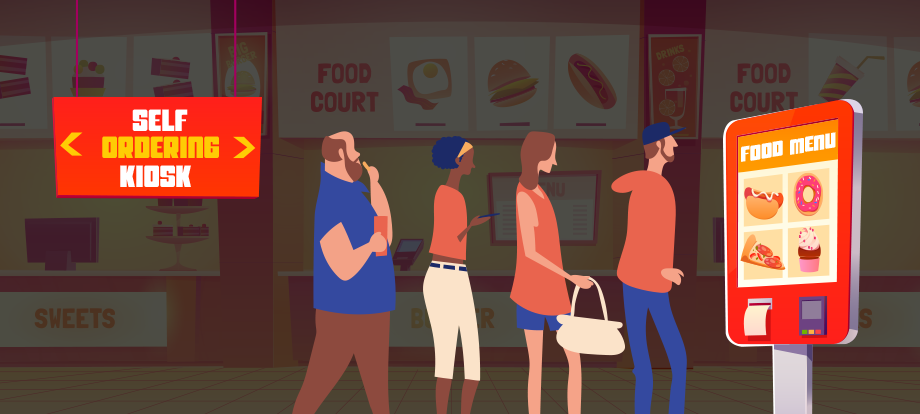
They have grown in prominence in the hospitality industry because of the numerous benefits of self-ordering kiosks to customers and restaurants.
The conventional self-ordering kiosk is a free-standing physical structure that displays the whole menu to consumers and allows them to place an order directly at the POS (according to their specific needs) without the intervention of a cashier or other staff.
Let us look at some of the reasons why these systems are so popular in quick-service restaurants, fast-food restaurants, casual dining establishments, and so on.
Self-Service Kiosks for Small Business
In today's fast-paced business landscape, small businesses are constantly seeking innovative & cost-effective ways to enhance their operations and improve the customer experience. Self-service kiosks have emerged as a valuable tool for achieving these goals.
These interactive terminals empower customers to independently browse, order, and complete transactions while providing small business owners with increased efficiency and cost savings.
Here are some of the benefits of self-service kiosks for the small-scale business:
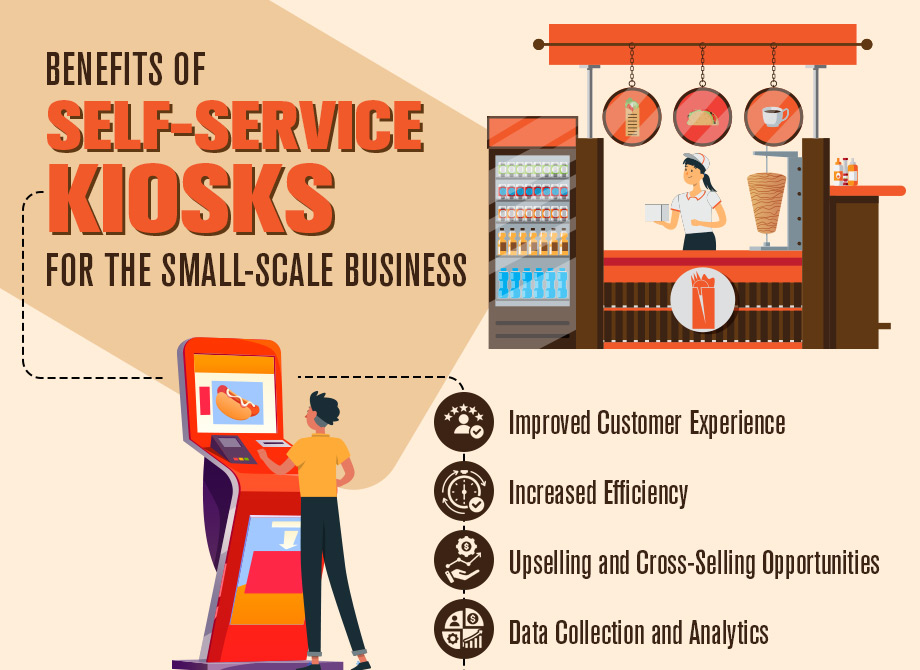
- Improved Customer Experience: Providing a seamless and convenient customer experience is crucial for small businesses. Self-service kiosks enable customers to have more control over their purchasing decisions, leading to increased satisfaction and loyalty.
- Increased Efficiency: Small businesses often face resource constraints, and self-service kiosks can help alleviate this burden. By allowing customers to independently place orders and access information, kiosks free up staff members to focus on other important tasks while saving up costs for small businesses.
- Upselling and Cross-Selling Opportunities: Self-service kiosks can suggest additional products or services based on customer preferences or purchasing history. It presents valuable upselling and cross-selling opportunities for small businesses leading to increased average order values and additional sales.
- Data Collection and Analytics: Gathering and analyzing customer data is vital for small businesses to make informed decisions. Self-service kiosks provide a rich source of data, and by leveraging this data - small businesses can refine their marketing strategies, tailor product offerings, and enhance the overall customer experience.
10 Benefits of Self-Ordering Kiosks for Your Restaurant
The benefits of self-ordering kiosks are varied and will set your restaurant up for success. With the right Kiosk and its implementation, you can leverage its out-of-the-box features - leading to enhanced customer satisfaction at lesser costs.
Below, we will be discussing the wide range of benefits that self-ordering kiosks bring to the table ranging from reduced wait times and convenient customer experience to higher revenues because of upselling and even making data-driven decisions for your businesses.
Let’s dig down and find out more about it.
Benefits of Self Ordering Kiosks
1. Reduced Wait Times
Let's be honest: standing in line sucks. Customers must stand there, gazing at the back of the person in front of them, trying not to drool on their clothing.
In fact, a Tillster survey indicated that 75% of customers would opt to order from a self-service kiosk if the line to purchase is longer than 5 persons.
What happens if there are 10 people in line? 91% of people say they would prefer to place their order at a restaurant kiosk.
Not to mention how long it might take cashiers to type in orders. You can put an end to all of that with kiosks. Your customers can simply walk up to the device, choose their order, make a payment, and they're done.
It is also beneficial for restaurants, as they're taking in more customers and fulfilling more orders without needing to hire more staff.
2. Convenient Contactless Experience
When the concept of contactless dining initially became available, it created a bit of confusion in the world. Due to its convenience and safety, it is now becoming more and more in demand. Customers can order and pay for goods and services through self-service kiosks.
Self-service kiosks can handle activities like splitting the cost. Almost 75% of customers rated the capacity for splitting the bill as their most requested self-payment option.
Customers can enjoy a great deal of convenience and comfort when a kiosk or other self-payment option is available. Approximately 61% of customers claim they now prefer buying from businesses accepting contactless payments.
Since there is no pressure from the server to check out early, customers get a satisfactory experience leading to more tips from them.
3. Increased Order Accuracy
Have your customers ever placed an order for a burger without pickles only to get one with more pickles - leaving them angry and unsatisfied?
It's a typical issue the restaurant business faces, and it's frustrating for both consumers and restaurant owners.
When customers place an order at your restaurant, they expect to get what they ordered. Using kiosks helps improve order accuracy.
Human errors are frequent when busy employees attempt to take so many orders, and kiosks help minimize this risk. Even while mistakes can still happen in the kitchen, the customer's order is precisely what is entered into the system and forwarded to the kitchen.
These consumer ordering systems also avoid miscommunications that can occur during the procedure.
As it is available in different languages plus comes with clear text and attractive visuals while eliminating the problem of order inaccuracy and enhancing customer satisfaction.
4. Increase Check Sizes
Self-service ordering kiosks greatly influence check sizes from your customers.
Simply put, you are not required to depend on your staff to upsell or cross-sell your customers. Self-ordering kiosks can increase the average check per client while drawing customers' attention to relevant products or add-ons.
It motivates clients to purchase more without the need for human intervention.
For instance, many rivals of McDonald's have discovered that touch-screen menu ordering systems encourage customers to spend more money.
The screen also features enticing images of dishes and sides that persuade clients to add them to their orders.
When it comes to upselling or putting your high-margin items in front and center of your customers, visuals are a crucial component of the self-ordering kiosks for your restaurant.
5. Preferred Ordering & Paying Method
With a self-ordering kiosk system for your restaurant, you're giving your customers the freedom to order the way they prefer. Some people enjoy browsing through a digital menu on a touchscreen kiosk, while others prefer using their smartphones to access a QR code and explore your menu.
With this system, you can cater to both preferences, ensuring a seamless and personalized ordering experience for everyone.
But that's not all. The best self-ordering kiosk system even simplifies the payment process too. Customers can choose their preferred payment method, whether it's cash, credit card, or mobile payment apps.
This flexibility not only saves time but also reduces the chances of errors during the payment process. It's a win-win situation for both you and your customers.
6. Improved Customer Experience
The customers at your restaurant sometimes look for personalized orders. Sometimes, they wish to substitute the fries for a salad or they might need to add more bacon to their burger.
But are hesitant to ask!
However, self-ordering Kiosks solve this problem as well.
Customers can order exactly what they want, whether it calls for more toppings, more cooking time, or anything else.
The customer will receive exactly what they want because the kiosk can provide all menu information (including nutritional and dietary metrics) along with other customization possibilities.
It saves the time of your workers and doesn’t have to memorize every possible and then mess it up later!
Customers don't have to worry about confusing the cashier or clogging the line by customizing their orders to suit their needs. It leads to improved consumer happiness, an upsurge in brand value, higher sales, and ultimately profitability.
7. Better Data-Driven Decisions
Customer and customer preferences are at the core of any business. Simply obtaining and exploiting the data you collect from your clients can significantly differentiate you from other businesses when it comes to focusing and advertising for new businesses.
Building a 360-degree perspective of your clients can enable you to spend your marketing budget more wisely and increase restaurant sales.
Touchscreen menu ordering systems can help you if you want to maximize the impact of your business's data by using it in a personalized and targeted way.
Kiosks give you the ability to gather a wide range of data touchpoints that you can utilize in your day-to-day operations to recommend and upsell customers as per their past preferences.
You can create a more profitable digital ordering process that your consumers will adore by studying key facts like the most popular menu items, preferred item arrangements, or preferred seasonings through the help of a self-ordering Kiosk.
8. Attractive In-Store Marketing
Quick-service restaurants have limited time to inform customers about exclusive deals, fresh menu items, and improved selections. In-store marketing includes marketing signage, menu boards, staff informing customers, and other effective methods. But, this marketing requires a significant amount of time and effort.
However, Restaurant kiosks or self-ordering systems are an easier alternative for marketing and keeping your customers updated with the best and latest marketing schemes.
Here’s everything you can do with self-ordering kiosks for in-store marketing:
- You can advertise your loyalty program to customers ordering food by using an ordering kiosk.
- It will increase the sign-ups keeping them informed, leading to a subsequent boost in subsequent revenue and customer engagement.
- If a new promotion becomes available in the middle of the day, you can notify clients in real-time.
With real-time updates and optimized in-store marketing, you can improve your marketing success rate without the need for your staff to promote a new sale or menu item. In this way, you can even reduce your marketing spending through other methods.
9. Lesser Staffing Costs and Better Management
Self-ordering kiosks for your restaurants are also helpful in addressing the productivity issue by enabling owners to shift workers as needed. The front-of-house workers who previously had to physically take orders can now concentrate on other duties that will boost sales and enhance the client experience.
With the out-of-the-box benefits of the kiosk for your restaurant, you may even speed up the meal preparation process and provide a better customer experience.
This type of flexible hiring increases productivity while also potentially lowering your overall labor costs. Although self-ordering kiosks cannot completely replace restaurant staff, they may allow you to have fewer employees on duty during peak hours.
Additionally, saving money on employee recruitment and management might help keep overhead expenses manageable for businesses with limited resources.
10. Better Remote Management
Self-service kiosks are a component of point-of-sale (POS) systems linked with each other over the Internet.
These high-end technology systems and portals enable restaurants to remotely monitor the systems seamlessly, enabling managers to oversee their restaurants regardless of the time and location.
What many restaurant operators may not realize is that self-service kiosks do far more than just take orders. They support inventory management and price regulation while monitoring customer information and habits through loyalty schemes.
All these details simplify restaurant administration, and having access to remote controls and monitoring enables management to conduct business even when they are not present.
Read on if you manage multiple restaurant locations: Remote monitoring and management are especially advantageous for franchisees who control or oversee many locations. They can easily log into the system to see what's going on at your locations - while tapping into better management.
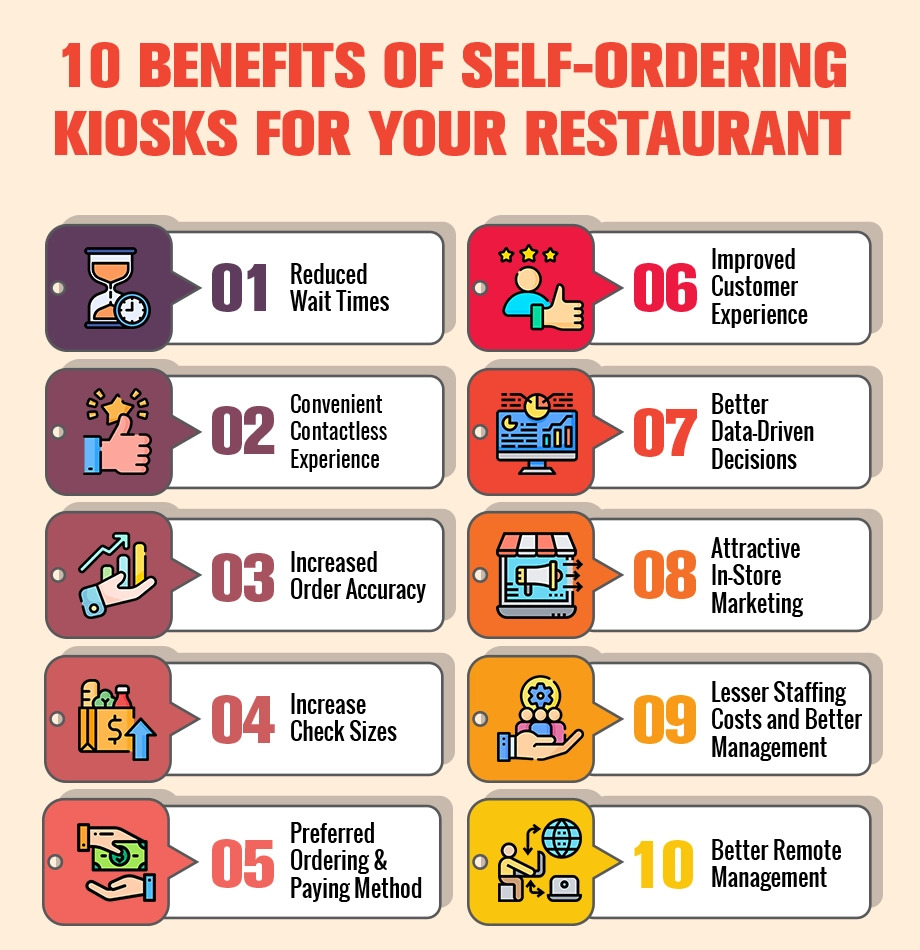
Key Features When Choosing a Restaurant Kiosk
Before choosing a restaurant kiosk, you need to consider the features it offers to ensure it has all the required functionality available for your business.
If not everything, it has some of the basic yet beneficial features such as menu management, end-to-end loyalty, and upselling, availability of real-time updates, along with a seamless and secure payment experience.
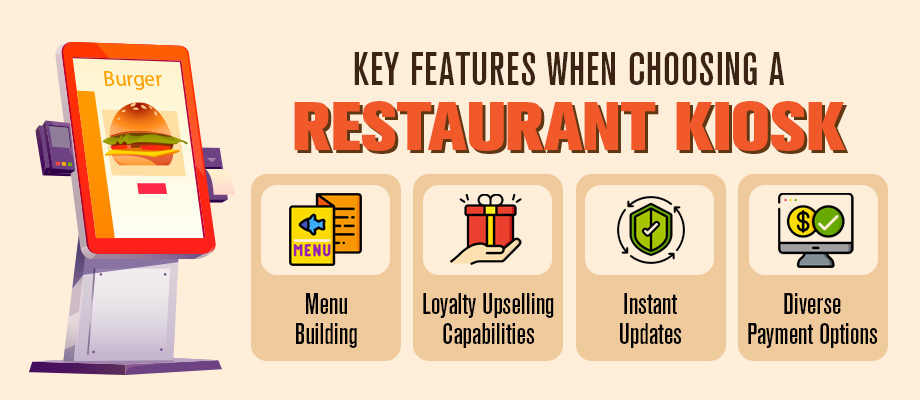
All these features can contribute to your restaurant's overall success and growth while delighting your customers with a convenient and personalized self-service solution.
Let’s find out more about these features and how they will be beneficial for your restaurant business:
1. Menu Building
A restaurant kiosk with robust menu-building capabilities allows you to easily create and manage your menu offerings. This feature enables you to showcase your dishes, prices, descriptions, and dietary information in an organized and visually appealing manner.
- Easy Menu Customization and Flexibility: The ability to customize your menu items, sections, and categories according to your restaurant's unique offerings and branding.
- Adding Images and Detailed Descriptions: Visual appeal plays a significant role in attracting customers, so ensure the kiosk allows you to include delicious images and comprehensive descriptions for each item.
- Categorization and Organization: A well-organized menu with categorized sections makes it easier for customers to navigate and find what they're looking for.
- Special Dietary Details: Touch screen menu ordering system offers all the related information regarding allergens, vegetarian or vegan options, gluten-free items, etc., to help customers make informed choices.
2. Loyalty Upselling Capabilities
Integrating loyalty and upselling features into your restaurant kiosk can help increase customer engagement, drive sales, and encourage repeat visits. These features provide personalized recommendations and incentives to customers, enhancing their overall satisfaction.
Here’s how a self-ordering kiosk can help you in loyalty & upselling:
- Loyalty Program Integration: Reward loyal customers by integrating your existing loyalty program into the kiosk, allowing them to earn points, redeem rewards, and enjoy exclusive offers.
- Upselling Prompts and Recommendations: Leverage customer data and ordering patterns to suggest additional items or upgrades that complement their selected choices, encouraging upselling.
- Cross-Selling Options: Promote complementary menu items or add-ons to increase the average order value and provide customers with a comprehensive dining experience.
- Integration With Customer Profiles and Order History: Utilize customer profiles and their past orders to personalize the experience further, making tailored recommendations based on their preferences.
3. Instant Updates
In a fast-paced restaurant environment, the ability to instantly update menu items, prices, and promotions is crucial - to serve trendy and required items to your customers. So, look for a restaurant kiosk that allows you to make real-time changes and modifications without the need for manual intervention.
- Cloud-Based Management System: A cloud-based system enables seamless updates across multiple kiosks, ensuring consistency in menu information and pricing.
- Automated Updates With Other Platforms: Get your hands on the restaurant's kiosk, which offers a seamless and automated reflection of updates(made on a restaurant kiosk) on a website or application to avoid confusion and maintain accuracy.
- Changes on the Go: When you introduce new dishes, limited-time offers, or price adjustments, the kiosk should make these updates instantly visible to customers, eliminating any lag time.
- Centralized Control and Administration: A centralized system allows you to efficiently manage and administer updates across all your kiosks while offering real-time updates regarding the inventory for seamless inventory management while also saving time and effort.
4. Diverse Payment Options
Offering a variety of payment options is essential to accommodate different customer preferences and increase convenience. Your restaurant kiosk should support various payment methods to ensure a smooth and hassle-free transaction process.
- Integration With Multiple Payment Gateways: Ensure that the kiosk can seamlessly connect to popular payment gateways, including credit cards and mobile payments platforms such as Apple Pay or Google Pay, along with digital wallets, allowing customers to choose their preferred method.
- Compatibility With NFC Technology: Contactless payments have become increasingly popular, so make sure the kiosk supports NFC technology for tap-and-go transactions, providing a quick and hygienic payment experience.
- Cash Payment Handling Capabilities: While digital payments are prevalent, some customers still prefer to pay with cash. Ensure that the kiosk has the ability to handle cash, including accepting it and providing change if necessary.
- Secure and Encrypted Payment Processing: To protect customer data and ensure secure transactions, verify that the kiosk's payment processing is end-to-end encrypted and compliant with industry standards.
What Is a Self-Ordering Tablet POS Kiosk? Its Benefits & Tips to Find an Ideal One
Above, we have discussed how self-ordering kiosks streamline restaurants' operations and management.
But what if you don’t need to invest hefty capital in incorporating this system or don’t have the extra space, or want to offer convenience to your customers?
No matter wherever your problem is, a Self-ordering tablet-based POS system is the solution!
This tablet-based system allows you to adapt to the new tech, provide a seamless customer experience, and save your staff time within your budget and space.
To know more about the Tablet-self ordering system benefits and some tips before choosing the ideal one, keep reading!
Benefits of self-ordering tablet kiosk for your restaurant:
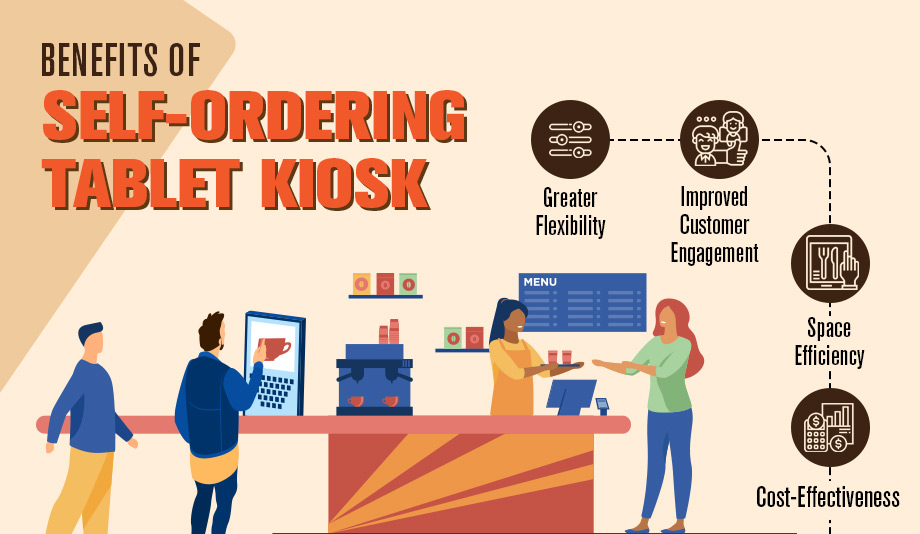
- Greater Flexibility: Self-ordering tablet systems offer greater flexibility in terms of placement and mobility. Unlike fixed kiosks, tablets can be easily handed to customers at their tables, allowing them to conveniently browse menus, customize orders, and make payments without leaving their seats.
- Improved Customer Engagement: Tablets provide a more intimate and interactive ordering experience. Customers can directly engage with the device, swiping through menus, zooming in on images, and exploring additional product information. This hands-on approach increases customer involvement and experience significantly.
- Space Efficiency: In establishments with limited space, tablets offer a space-saving alternative to larger kiosks. Since tablets can be placed on tables or mounted on stands, they require minimal floor space, allowing businesses to accommodate more customers and optimize their seating arrangements.
- Cost-Effectiveness: Self-ordering tablet systems are often more cost-effective than traditional kiosks. Tablets are generally less expensive to purchase and maintain compared to larger kiosks. Furthermore, tablet systems can often be easily integrated with existing POS systems while also minimizing the need for additional hardware investments.
Tips for choosing the best self-ordering tablet system:
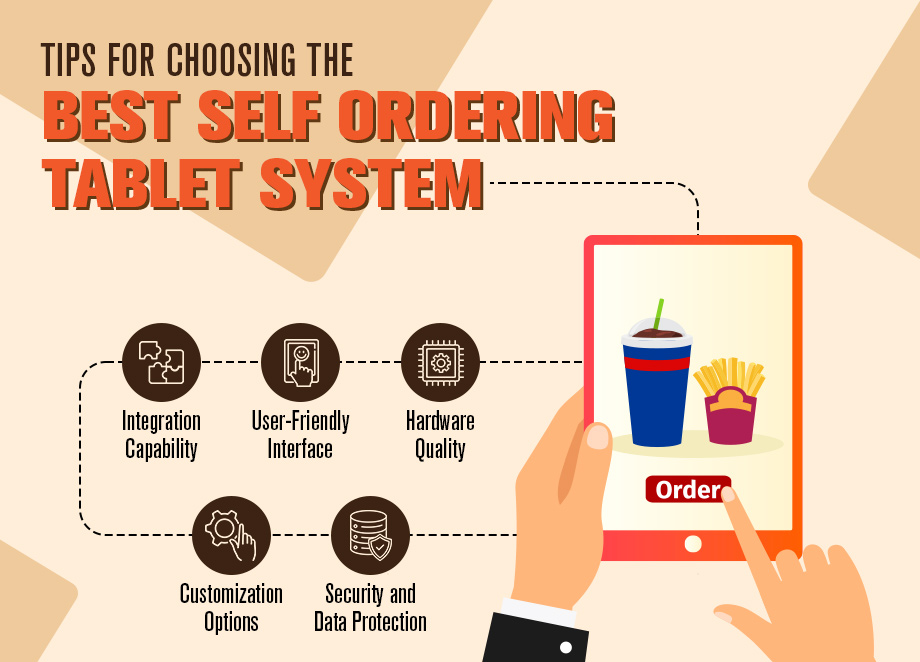
- Hardware Quality: Ensure the tablets are of high quality, with durable construction and reliable touchscreens. Tablets with long battery life and robust processing power will ensure smooth operation throughout the day.
- User-Friendly Interface: Look for self-ordering tablets with intuitive and user-friendly interfaces. The menu navigation and user experience should be simple and visually appealing, allowing customers to browse through options easily and place orders without confusion.
- Integration Capability: Choose a self-ordering tablet system that seamlessly integrates with your existing POS software, kitchen management systems, and payment processors - for better restaurant operations management and increased efficiency.
- Customization Options: Opt for tablets that allow you to customize the interface to match your brand's aesthetics and visual identity. It creates a cohesive and immersive customer experience that aligns with your restaurant’s visuals.
- Security and Data Protection: Opt for a tablet kiosk that includes robust security features, such as encrypted payment processing and secure data storage. As you know, protecting customer information and ensuring secure transactions is crucial for building trust and maintaining compliance with data protection regulations.
Wrapping Up
Self-ordering kiosks are shaping the future of dining as more and more restaurants use them to make things easier and more effective for staff and consumers.
The benefits of Kiosks in restaurants are immense, including increased customer happiness, decreased costs, increased revenues, and better staff management.
There is no doubt that self-service kiosks necessitate a significant one-time expenditure. However, the advantages and long-term cost-effectiveness considerably exceed the one-time costs. The increasing popularity of these kiosks demonstrates the fact that the investment is well worth it.
You can even choose to go with tablet-based kiosks that interact with your current POS system to forego that significant expenditure. They are a far more cost-effective and user-friendly solution for independent restaurants.
Frequently Asked Questions(FAQs)
01 What is a QR Based Table Kiosk? Can I use it Instead of a Self-Ordering Kiosk System?
A QR-based table kiosk is a technology that restaurants employ to make ordering easier. Customers can order this by using their phones.
The table kiosk using QR technology is quick and easy. There is a QR code on each table in the restaurant. Customers can use their phones to scan the barcode and can view the menu and pricing. Once they've selected what to eat, the consumer can place their order using their phone.
And, yes, you can surely use it instead of the physical self-ordering kiosk for your restaurant.
Here’s why?
- Cost-effective alternative to traditional self-ordering kiosk systems.
- Easy implementation without the need for additional hardware.
- Allows customers to use their own devices for greater convenience.
- Provides a contactless ordering experience for hygiene and safety.
This option is popular for restaurants who want to provide their guests the benefit of high-end sophisticated technology without investing in equipment. It can save restaurants thousands of dollars, and it's also a quite simple method to use.
02 Is Restaurant Kiosk the Future of the Restaurant Business?
Considering the benefits it offers to the customers while also generating beneficial outcomes for the restaurants, we can say that restaurant kiosks are the future of the restaurant industry.
According to research, 65% of consumers would return to a restaurant if self-service kiosks were available, and 30% prefer to purchase from a touch-screen menu ordering system rather than the ordering counter.
Big fast-food chains and quick-service dining establishments, such as Chili's and McDonald's, had previously implemented and experienced the benefits of self-ordering kiosks in their restaurant.
Following the installation of these kiosks, McDonald's claimed an average 5%–6% rise in sales, and Chili's reported a whopping 20% increase in dessert sales.
Here is why?
- Kiosks are created to provide a quick and more individualized ordering experience.
- Customers can easily personalize their meals, place orders, and even make payments through their preferred payment method.
- It enables customers to order and pay for their meals without interacting with the staff.
To save on the substantial cost of installing self-ordering kiosks and avail greater convenience, many restaurants opt for self-ordering tablet-based POS kiosks to get the best benefits at lower costs and greater convenience.
03 How to Set- up My Kiosk, and What are Further Steps to Follow?
If you are looking for a step-by-step implementation guide to set up the self-ordering kiosk in your restaurants, then check out the following points.
- Choose the Right Kiosk for Your Restaurants: The first step in implementing kiosk solutions for centralized kiosk administration is to select the appropriate software. There are various alternatives available, so do your homework and pick the one that best satisfies your restaurant's requirements.
- Implementing Your Kiosk : After you've installed your software, it's time to configure your kiosks. Place them in a visible area with clear advertising and instructions on how to use them. In order to make your kiosks appear more inviting to customers, think about incorporating your personal branding.
- Train Your Staff : Your employees are crucial to the success of your kiosks. Make sure you teach them how to utilize the software so they can help clients and keep things running smoothly.
- Keep an Eye on Your Kiosks : Once your kiosks are operational, it's crucial to routinely check on them. It will enable you to rapidly detect and address any difficulties. Analyzing the information from your kiosks is also crucial. You'll be able to spot trends, decide on your menu, prices, and marketing initiatives with the collected information.
04 What are the Benefits of Self-ordering Kiosk & POS Systems Integration?
Integrating a restaurant kiosk with a POS system improves the variety of benefits for your restaurant business. And these benefits contribute to a more streamlined and customer-centric dining experience while driving significant cost savings and supporting business growth.
Integrating a restaurant kiosk with a POS system offers the following benefits:
- Streamlined Operations: Restaurant kiosk integration with the POS system ensures that orders placed through the kiosk are seamlessly transferred to the POS system, eliminating the need for manual data entry. It reduces errors, enhances order accuracy, and streamlines the overall order management process.
- Real-Time Inventory Management: Inventory levels are automatically updated in real-time by integrating the kiosk with the POS system. It allows restaurant staff to monitor stock levels, track ingredient usage, and ensure efficient supply management.
- Faster Service and Reduced Wait Times: Integrated kiosks enable faster order processing and reduce customer wait times. Orders placed through the kiosk are immediately sent to the kitchen or bar, expediting the preparation process and improving overall service efficiency.
- Seamless Payment Processing: Integrated kiosks can process payments directly through the POS system, ensuring a secure and efficient payment process along with payment updates as well. It will further help in accounting as well.
- Cost Savings: With automated inventory, payments, orders, and other updates - it will further allow the staff to focus on other restaurant business operations while saving up costs.
05 What is the Cost of Installing Self-Ordering Kiosks for My Restaurant?
The cost of installing different types of self-ordering kiosk systems can vary depending on several factors, such as your business’ custom requirements, its feature, kiosk provider, type of kiosk, and other things around.
Here's a general overview of the cost considerations for various types of self-ordering kiosk systems:
- Traditional Self-Ordering Kiosk: Traditional self-ordering kiosk is a large, standalone device with touchscreen interfaces. The cost of these kiosks can vary widely based on factors such as screen size, build quality, processing power, and additional features. An average estimate for a basic self-ordering kiosk can range from $3,000 to $10,000 or more per unit.
- Self-Ordering Tablet Kiosk: Tablet self-ordering kiosks utilize tablets mounted on stands or attached to tables. The tablets cost around $300 to $1000, depending on the brand, model, and specifications.
- QR Code-Based Kiosk: QR code-based kiosks typically rely on customers using their own devices to scan QR codes placed on tables or other designated areas - which can cost around $100 to $500 for the QR codes and a tablet or POS system for the updates.
- Hybrid Systems or Custom Solutions: Some businesses may opt for hybrid solutions or custom-developed self-ordering kiosk systems that combine different technologies or integrate with existing POS systems. Hybrid or personalized kiosks cost around $1000 to $10,000. The cost is higher than a normal or tablet kiosk.
While calculating the cost of installing a self-ordering kiosk for your restaurant, you should also keep in mind factors such as maintenance, training, software licensing fees, potential future upgrades, etc.